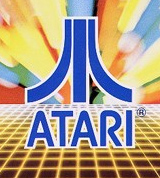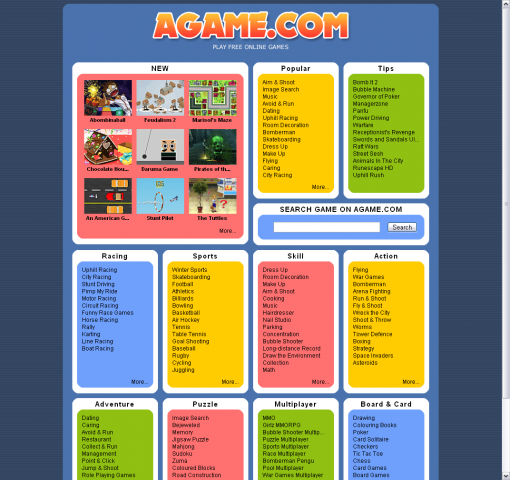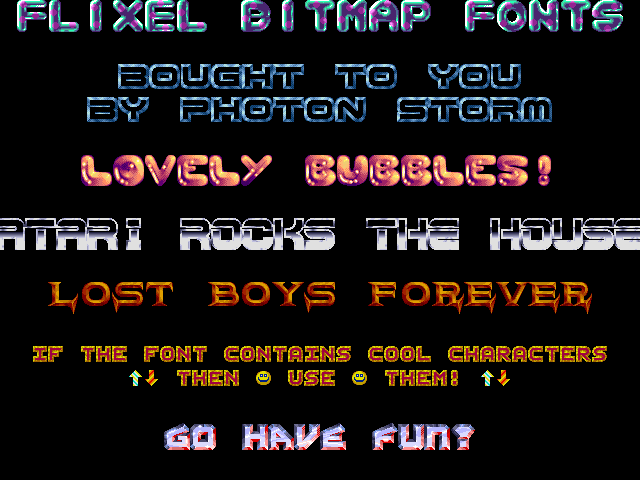Posts Tagged ‘atari’
-
FlxBitmapFont – A Bitmap Font class for Flixel 2 released
21st May 201010Today I released my FlxBitmapFont package to Google Code. This allows you to use bitmap fonts directly in your Flixel 2 games:
The bitmap fonts are just an extension of a Flixel Sprite, meaning you can throw them around, collide with them, scale them, rotate them and generally cause havoc. Or of course they could just be UI elements, proving a score/lives count. But at least the choice is yours 🙂
11 fonts are included, 2 sample programs and comprehensive documentation in the form of a PDF file. I’ve also published that here on my blog: http://www.photonstorm.com/flxbitmapfont and I will update both my blog and the Google Code archive as needed.
Anyway I hope you have fonty fun with this! Look out for a number of new Flixel classes from me in the coming months, or catch me on the flixel forums where I help moderate the place.
-
A lot of people have ideas …
3rd Jan 2010 “The critical ingredient is getting off your butt and doing something. It’s as simple as that. A lot of people have ideas, but there are few who decide to do something about them now. Not tomorrow. Not next week. But today. The true entrepreneur is a doer, not a dreamer.”
“The critical ingredient is getting off your butt and doing something. It’s as simple as that. A lot of people have ideas, but there are few who decide to do something about them now. Not tomorrow. Not next week. But today. The true entrepreneur is a doer, not a dreamer.”Nolan Bushnell
-
DarkCubes released – Retro 16-bit demoscene gameyness
1st Oct 2009Away3D is an awesome 3D library for Flash. Flod is an awesome library for replaying tracker music in Flash. Throw those two things together with my inner-geek upbringing of the 80s and you get DarkCubes. I grew up drip-fed on ST/Amiga demo effects, and this random little 3D game is what I banged out during a couple of lunch breaks and some hours last night.

I actually wrote DarkCubes back in 2000 on the PC/Windows using DarkBASIC (hence the title of the game). So I had the code and figured it would make a good first experiment for Away3D. A bit of messing around, a bit of swearing, and lots of fiddling later and this tiny puzzler was born.
The logo is from the original PC game and was made by Yann ‘Kohai‘ Parmentier. The music is by Adam Sikorski (DSX of TRSI), 505 of Checkpoint and Toodeloo of the Dead Hackers Society. The rest by yours truly.
Lots of keys do stuff in-game, so have a fiddle! (1-5 changes the music for example, D turns on Debug info, 7-9 change texture, etc. Read the scroller for the full list).
I make no apologies for this beating shitty spec Netbooks / PCs over the head with a giant CPU grinding axe. Deal with it. It’s hardly the end of the world.
Click here to play (sorry no pre-loader, but it’s only 1MB in size)
Enjoy 😉
-
Octopod! One of my first ever games :)
17th Jul 2009While digging through a huge stack of old Atari ST disks I found one which contained a bunch of my first ever ST games and demos. Created with STOS these are extremely primitive pieces (even by the standards of the late 1980s!) but I found it amusing watching and playing them all the same.
My very first real game was called Octopod. It involved shooting octopus, which for no sane reason would drop a gold coin after they exploded in red meaty chunks. Shoot the coin and you got points. Don’t shoot the octopus fast enough and you lost a life. Playing the game back tonight I found it insanely hard! Either my reflexes are vastly reduced now, or it doesn’t run quite the same under emulation 😉
Eitherway I present you a video of Octopod (sans music, as Camtasia was being a dick re: recording inputs)
[swfobj src=”http://sandbox.photonstorm.com/octopod.swf” width=”660″ height=”478″]
At the start you will see it’s inside the STOS editor. At the time this was a quite nice place to work, and reasonably well featured. You could have memory resident programs loaded into membanks, so you could switch between say the compiler or sprite editor at the press of a few keys. The block across the top is where you’d assign a sequence of key commands to function keys. The nasty salmon colour scheme is my fault, the default was white text on black. Remember back then most of us coded using TV sets, so this could be quite painful after extended periods of time!
I do a “list” at the start so you can view the source code and have a giggle. Oh and yes, you had to use line numbers! Only with AMOS on the Amiga did they drop that restriction. You can find out loads more about STOS at the STOS Time Tunnel web site.
I’m now considering re-coding it in Flash as part of the GYM Board 30 minute challenge 🙂
-
My new game Abombinaball finally released!
20th Nov 2008 Well I’m glad to say that after several months Abombinaball is finally out for the public to play! I put the development version on Flash Game License, eventually sold it to SpilGroup, had to translate it into 16 different languages (a hell of a lot of work) and it went live across the world today.
Well I’m glad to say that after several months Abombinaball is finally out for the public to play! I put the development version on Flash Game License, eventually sold it to SpilGroup, had to translate it into 16 different languages (a hell of a lot of work) and it went live across the world today.According to my tracking stats it’s going down well, SpilGroup certainly have a decent chunk of traffic. Sadly they got the SWF dimensions wrong when putting live, but I’ve emailed them and it’s being fixed now! So the high rating it currently has is despite the fact the graphics look a bit screwed!
Will keep an eye on play totals and report back how it goes in a few days.
I was pleased to see that Stickhead over at The Joy of Sticks blog (a superb Atari ST blog!) wrote a nice comparison of my version with the original including videos. You can read that here. Here’s a video of the game taken from YouTube (created by The Joy of Sticks):
Oh and Jeff/Steve if you’re reading this, you can now post about the little easter egg in it 🙂
You can play it on Agame.com or the translated versions at UK English, Netherlands, German, French, Spanish, Italian, Polish, Swedish, Portuguese, Russian, Turkish, Latin American, Brazilian, Indonesian and Malaysian.
Hire Us
All about Photon Storm and our
HTML5 game development services
Recent Posts
OurGames
Filter our Content
- ActionScript3
- Art
- Cool Links
- Demoscene
- Flash Game Dev Tips
- Game Development
- Gaming
- Geek Shopping
- HTML5
- In the Media
- Phaser
- Phaser 3
- Projects
Brain Food





